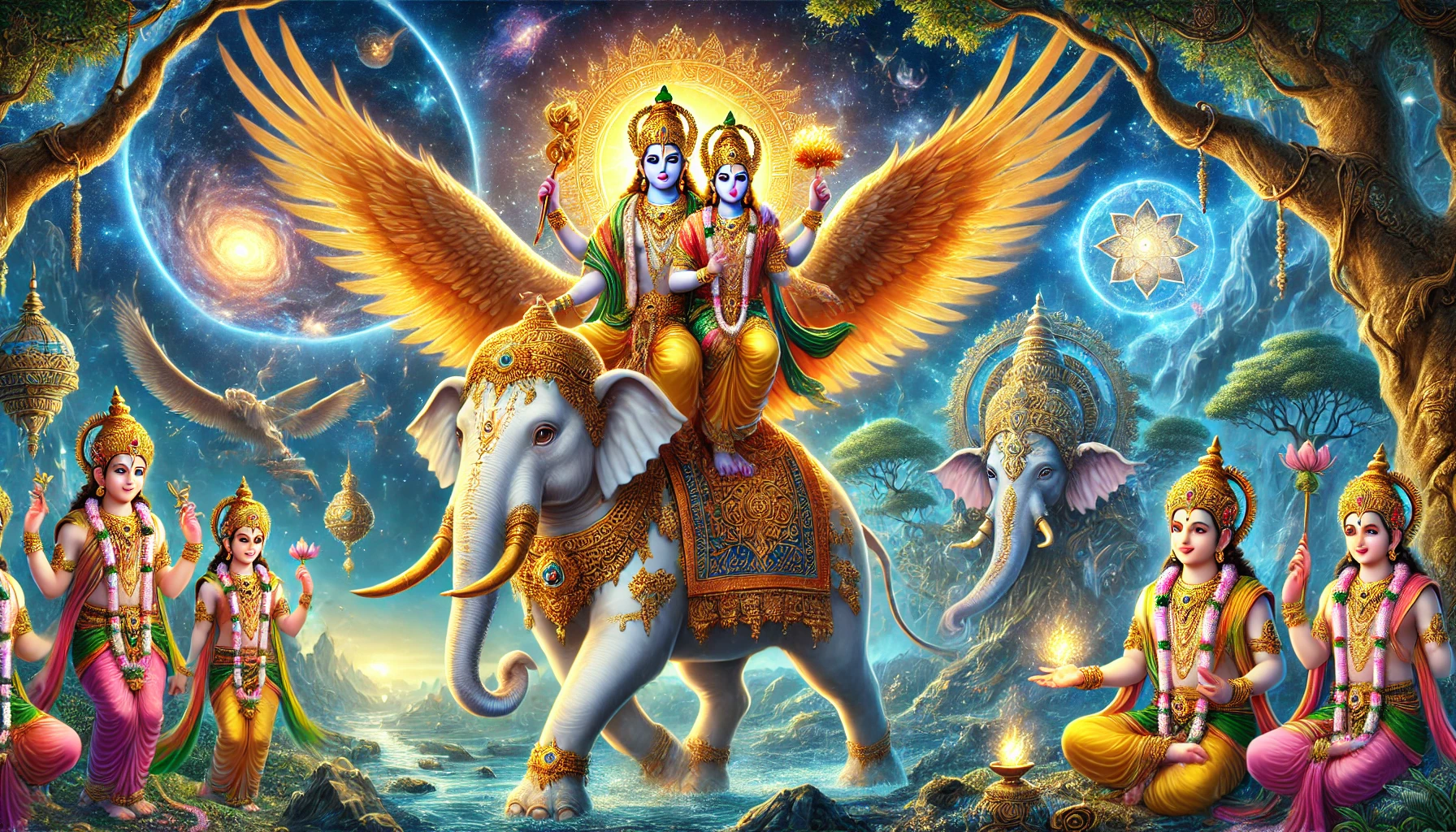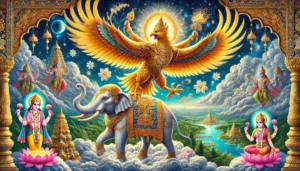
Celestial creatures in Indian mythology
Stories of Garuda, Airavata, and Other Divine Beings
Hindu mythology is an expansive realm where gods, sages, and celestial beings interact to maintain the balance of the cosmos. Among these, divine creatures such as Garuda, Airavata, and others hold a unique place, symbolizing virtues, cosmic principles, and spiritual truths. Their stories serve as a bridge between the mortal and the divine, offering profound lessons that resonate through time.
Garuda: The Mighty King of Birds
Garuda, the vahana (mount) of Lord Vishnu, is a majestic figure in Hindu mythology. His form, part eagle and part human, symbolizes immense power, agility, and spiritual liberation. Beyond being Vishnu’s loyal carrier, Garuda is a symbol of overcoming ignorance and worldly bondage.
One of the most famous tales of Garuda involves his quest for the Amrita (nectar of immortality). His mother, Vinata, was enslaved by Kadru, the mother of serpents, due to a bet lost over the color of Ucchaihshravas, the celestial horse. To free her, Garuda agreed to bring the Amrita from the gods. Braving countless obstacles, including guarding fire and fierce serpents, Garuda succeeded but ensured the nectar never fell into the wrong hands. This story reflects his devotion, strength, and adherence to dharma.
Garuda is also a protector of dharma, often invoked to dispel fears and protect devotees from negative forces. His image is frequently seen atop temple spires and in sacred art, symbolizing protection and divine guidance.
Table of Contents
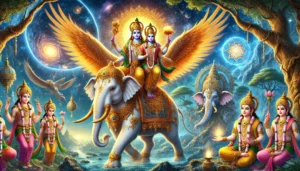
Celestial creatures in Indian mythology
Airavata: The Celestial Elephant
Airavata, the spotless white elephant, serves as Lord Indra’s mount and stands as a symbol of rain, abundance, and prosperity. Born from the cosmic churning of the ocean (Samudra Manthan), Airavata is described as a majestic being with multiple trunks, capable of reaching the heavens and drawing water from the underworld to bless the earth with rain.
Airavata’s role extends beyond being Indra’s vahana; he is a guardian of the eastern direction and protector of cosmic order. A tale of his greatness is found in the Mahabharata, where he revives a parched and desolate land suffering under drought. By spraying life-giving water, Airavata restores balance, ensuring the survival of the people. His presence in mythology underscores the interconnectedness of nature and divine will.
In spiritual symbolism, Airavata is also associated with mental clarity, wisdom, and the idea that purity of thought and action can lead to spiritual and material fulfillment.
Nandi: The Devoted Bull
Nandi, the sacred bull, is more than just Lord Shiva’s mount—he is a symbol of devotion, power, and moral integrity. In temples dedicated to Shiva, Nandi is often enshrined facing the deity, a testament to his eternal vigilance and devotion.
The story of Nandi begins with Sage Shilada, who performed intense austerities to have a child blessed by Lord Shiva. Shiva granted him Nandi, who grew to become Shiva’s most loyal attendant. Nandi’s unparalleled devotion is reflected in his role as Shiva’s gatekeeper, allowing only the pure of heart to enter the deity’s sanctum.
One notable tale involves Nandi cursing Ravana, the demon king of Lanka. When Ravana attempted to lift Mount Kailash, Nandi thwarted him and cursed him, predicting the destruction of his arrogance and empire. This act of loyalty emphasizes the virtues of humility and devotion.
Nandi also holds significance in agriculture and fertility. As a bull, he represents the power of nature, the sustenance of life, and the strength required to nurture the land.
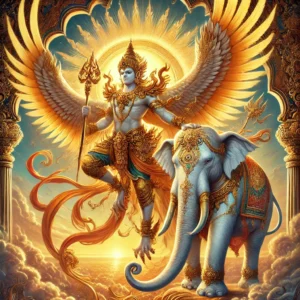
Celestial creatures in Indian mythology
Kamadhenu: The Wish-Granting Cow
Kamadhenu, the divine cow, is revered as a symbol of abundance, purity, and selflessness. She is said to have emerged from the Samudra Manthan and became the mother of all cows. Known for her miraculous ability to grant any wish, Kamadhenu embodies the nurturing aspect of nature.
One of her most famous associations is with Sage Vasishta, who owned her as part of his ashram. Kamadhenu provided the sage with all that he needed to sustain his hermitage and its disciples. When King Vishwamitra attempted to seize Kamadhenu, the cow miraculously produced an army to defend herself, demonstrating her divine origin and power.
Kamadhenu’s significance extends beyond mythology. She is a symbol of ecological balance, nurturing, and the interconnectedness of all living beings. Her association with cows in general reinforces the idea of ahimsa (non-violence) and the sacred relationship between humans and animals.
Sharabha: The Fierce Protector
Sharabha, an eight-legged mythical creature, is a lesser-known but powerful form of Lord Shiva. Depicted as part lion and part bird, Sharabha emerged to subdue the wrath of Narasimha, the lion-man avatar of Vishnu, after he had slain the demon Hiranyakashipu.
Sharabha represents the balance of power and justice, embodying Shiva’s role as a cosmic regulator. His story illustrates the necessity of maintaining harmony, even among the divine forms, and emphasizes that unchecked power must always be balanced by wisdom.
Uchchaihshravas: The Celestial Horse
Uchchaihshravas, the seven-headed horse, is another divine being born during the churning of the ocean. Known for his speed and grandeur, Uchchaihshravas became a symbol of glory and majesty. Though often associated with Indra, the horse is also linked to Bali, the demon king, reflecting its universality and significance in both divine and asura realms.
In some interpretations, Uchchaihshravas represents the pursuit of unattainable ideals, urging humanity to strive for greatness and higher spiritual truths.
Garuda and the Nagas: A Symbolic Rivalry
Garuda’s enmity with the Nagas (serpent beings) is a recurring theme in Hindu mythology. Despite their rivalry, the Nagas, such as Ananta and Vasuki, also hold significant spiritual symbolism. Ananta, the infinite serpent on which Lord Vishnu rests, represents eternity and cosmic balance.
The interplay between Garuda and the Nagas highlights the duality of existence—light and shadow, freedom and bondage. Their stories teach us the importance of overcoming inner conflicts to achieve harmony.
Other Celestial Beings
Jatayu and Sampati: These vulture brothers from the Ramayana exemplify courage and sacrifice. Jatayu, mortally wounded while trying to rescue Sita from Ravana, represents unwavering duty to dharma. Sampati, his elder brother, assists Rama in locating Sita, showcasing redemption and purpose.
Takshaka: The serpent king Takshaka, though a Naga, is central to several stories in the Mahabharata. His enmity with the Kuru dynasty and role in Parikshit’s death underline the complexities of karma and cosmic justice.
Vasuki: The serpent Vasuki played a pivotal role in the Samudra Manthan, serving as the churning rope. His sacrifice and endurance symbolize the necessity of pain and effort in achieving great results.
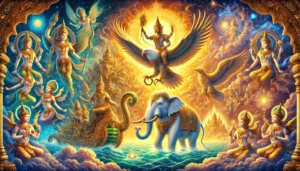
Celestial creatures in Indian mythology
The Eternal Relevance of Divine Beings
The stories of these divine creatures are more than mythology; they are profound allegories that guide us toward higher truths.
Garuda teaches us the value of devotion and liberation from ignorance.
Airavata represents the sustenance and harmony of nature.
Nandi embodies unwavering loyalty and spiritual discipline.
Kamadhenu reminds us of the virtues of generosity and ecological balance.
Together, these beings inspire us to live in harmony with nature, uphold dharma, and strive for spiritual and personal growth. Through their tales, we glimpse the interconnectedness of all life, reinforcing the timeless wisdom of Sanatan Dharma.
FAQs on “Legends of Garuda, Airavata, and Celestial Creatures: Tales of Devotion, Power, and Cosmic Balance”
- Who is Garuda, and what does he symbolize?
Garuda is the king of birds and the divine mount (vahana) of Lord Vishnu. He is depicted as part eagle and part human and symbolizes speed, strength, devotion, and liberation from ignorance. His story of retrieving the Amrita (nectar of immortality) is a powerful allegory for courage, perseverance, and dharma.
- What is the significance of Airavata in Hindu mythology?
Airavata is the celestial white elephant and the mount of Lord Indra. He symbolizes abundance, purity, and rain. As a guardian of the eastern direction, Airavata plays a role in maintaining cosmic balance. His birth during the Samudra Manthan signifies the interconnectedness of the natural and divine worlds.
- What is Nandi’s role in Shiva worship?
Nandi, the sacred bull, is the vahana of Lord Shiva and a symbol of loyalty, strength, and devotion. He acts as Shiva’s gatekeeper, allowing only the pure-hearted to enter. Devotees often whisper their wishes into Nandi’s ears, believing that he will convey them to Shiva.
- Who is Kamadhenu, and why is she considered sacred?
Kamadhenu is the divine wish-fulfilling cow that emerged from the Samudra Manthan. She symbolizes abundance, selflessness, and the nurturing aspect of nature. Kamadhenu is revered as the mother of all cows and represents the ecological and spiritual harmony emphasized in Sanatan Dharma.
- What is the story behind Sharabha in Hindu mythology?
Sharabha is an eight-legged mythical creature, part lion and part bird, representing Shiva’s fierce aspect. He appears to pacify Narasimha (the lion-man avatar of Vishnu) when his wrath becomes uncontrollable. Sharabha embodies balance, wisdom, and the necessity of cosmic regulation.
- What is the role of Uchchaihshravas in Hindu texts?
Uchchaihshravas, the seven-headed celestial horse, emerged during the churning of the ocean and is considered a symbol of glory, speed, and spiritual aspiration. Though primarily associated with Indra, he is sometimes linked to Bali, the demon king, showing his universal significance.
- Why do Garuda and the Nagas have a rivalry?
Garuda and the Nagas (serpents) are eternal rivals in Hindu mythology. This rivalry began when Garuda’s mother, Vinata, was enslaved by Kadru, the mother of the Nagas. Despite their enmity, the Nagas also play significant roles, with Ananta (the infinite serpent) serving as Vishnu’s resting bed, representing cosmic balance.
- What does the story of Jatayu teach us?
Jatayu, the vulture king from the Ramayana, sacrificed his life trying to save Sita from Ravana. His story teaches the values of courage, selflessness, and upholding dharma, even in the face of certain defeat.
- Who is Takshaka, and what is his role in mythology?
Takshaka is the serpent king who plays a key role in the Mahabharata. He is responsible for the death of King Parikshit and is associated with themes of karma, cosmic justice, and the interdependence of humans and nature.
- What lessons can we learn from these divine beings?
Each divine being conveys unique spiritual lessons:
Garuda: Devotion, strength, and liberation.
Airavata: Balance, abundance, and purity.
Nandi: Unwavering loyalty and discipline.
Kamadhenu: Generosity and ecological harmony.
Sharabha: Balance of power and wisdom.
These stories remind us to live harmoniously, uphold dharma, and strive for spiritual and personal growth.
- Are these beings worshipped in modern Hindu practices?
Yes, many of these divine beings are revered in Hinduism. Garuda and Nandi are prominently featured in temples of Vishnu and Shiva, respectively. Airavata and Kamadhenu are invoked in prayers for rain, prosperity, and abundance. They are not just mythological figures but also integral symbols in daily rituals and festivals.
- How are these stories relevant today?
The tales of Garuda, Airavata, Nandi, and others offer timeless wisdom. They emphasize virtues like courage, loyalty, selflessness, and the importance of living in harmony with nature. These lessons are especially relevant in today’s fast-paced world, where reconnecting with spiritual and ecological values can bring balance and peace.
For further insights into these divine beings, explore their depictions in texts like the Mahabharata, Ramayana, and Puranas, which offer profound allegories and teachings.
Summary
“Legends of Garuda, Airavata, and Celestial Creatures: Tales of Devotion, Power, and Cosmic Balance”
Hindu mythology is enriched with tales of divine beings that transcend the human realm, weaving together profound spiritual lessons and cosmic symbolism. Among these celestial entities, Garuda, Airavata, and other mythical creatures hold a unique and revered position. These divine beings not only serve as the vahanas (mounts) of gods but also embody virtues such as devotion, power, and the eternal balance of the cosmos. Their stories are timeless, offering moral and spiritual insights relevant to every age.
Garuda: The King of Birds
Garuda, the loyal mount of Lord Vishnu, represents courage, freedom, and the triumph of devotion over adversity. His quest to retrieve the Amrita (nectar of immortality) to free his mother, Vinata, from servitude is a story of love, sacrifice, and perseverance. Garuda’s unwavering devotion to Vishnu and his eternal enmity with the Nagas serve as allegories for the victory of dharma over adharma and the journey to spiritual liberation. His tales inspire us to rise above ignorance and worldly attachments.
Airavata: The Celestial Elephant
Airavata, the spotless white elephant, emerged from the cosmic churning of the ocean and became the vahana of Indra, the king of gods. Known for his multiple trunks and majestic form, Airavata symbolizes prosperity, fertility, and the life-giving force of rain. He is often depicted bringing water from the heavens to nourish the earth, emphasizing the interconnectedness of nature and divine will. His stories highlight the significance of balance, purity, and the role of natural forces in sustaining life.
Nandi: The Sacred Bull
Nandi, the devoted mount of Lord Shiva, embodies loyalty, strength, and spiritual vigilance. A constant guardian at the entrance of Shiva temples, Nandi is a symbol of unwavering devotion and service to the divine. His tales, including his role as a protector of Mount Kailash and his curse upon Ravana, reflect his steadfastness and moral integrity. Nandi also represents agricultural abundance, making him a symbol of life’s sustenance and harmony with nature.
Kamadhenu: The Wish-Granting Cow
Kamadhenu, the miraculous cow born during the churning of the ocean, is a symbol of abundance, selflessness, and the nurturing power of nature. Her ability to grant any wish and her role as a divine protector in Sage Vasishta’s hermitage underscore her spiritual and ecological significance. Kamadhenu embodies the concept of ahimsa (non-violence) and the interconnectedness of all beings.
Sharabha: The Fierce Protector
Sharabha, an eight-legged mythical creature, is a form of Lord Shiva that represents ultimate control over cosmic chaos. Born to subdue the wrath of Narasimha, Sharabha’s tale reflects the balance between unbridled power and wisdom, showcasing Shiva’s role as the cosmic regulator.
Other Celestial Beings
Uchchaihshravas, the seven-headed celestial horse, symbolizes glory and the pursuit of higher ideals.
Jatayu and Sampati, the vulture brothers from the Ramayana, embody sacrifice and redemption, aiding Lord Rama in his quest to rescue Sita.
Takshaka and Vasuki, prominent serpent beings, highlight the duality of existence and the role of cosmic justice in mythology.
Themes and Symbolism
The legends of these divine beings extend beyond mere storytelling. They are profound allegories representing cosmic principles, spiritual aspirations, and the relationship between humanity and nature. Garuda teaches the importance of liberation and devotion, Airavata symbolizes the nurturing aspects of nature, Nandi exemplifies unwavering loyalty, and Kamadhenu reinforces the sanctity of life and generosity. Together, these beings inspire a life aligned with dharma, harmony, and spiritual growth.
Through the stories of these celestial creatures, Hindu mythology underscores the interconnectedness of the divine and the mortal realms. These tales continue to resonate with their timeless wisdom, reminding us of the virtues of courage, selflessness, and the eternal quest for cosmic balance.
Related Articles
- The Tridevi: Lakshmi, Saraswati, and Parvati – Their Roles and Powers
- “Divine Creatures of Ancient Indian Scriptures: Exploring the Role of Animals in the Vedas, Puranas, and Mahabharata”
- Nature and Spirituality: Exploring the Sacred Essence of the Himalayas, Ganga, and Other Natural Wonders”
- “Reviving the Gurukul System: Relevance and Lessons for Modern Education”
- “Exploring Greek and Indian Mythology: Similarities Between Greek and Indian Mythology “
- “Embracing Sattvic Living: Harmonizing Mind, Body, and Soul Through Food and Lifestyle”
- “Charity and Prosperity: Exploring the Concept of Daan and Its Financial Relevance in Modern Life”
- How to Build an Eco-Friendly Home Inspired by Vastu Shastra
- Comparison of Ancient and Modern Sports: How Traditional Sports Have Influenced Contemporary Games
- “Timeless Lessons from Ancient Tales: Linking Samudra Manthan and Ganga’s Descent to Modern Ecological Challenges”
- “Reviving Sanskrit: How AI is Preserving Ancient Languages for the Future”
- “Mathura: The Sacred Land of Lord Krishna’s Divine Leelas”
- Investing for Future Generations: Lessons from Indian Traditions on Legacy Building and Wealth Preservation
- “Ancient Indian Wisdom: Timeless Lessons for Tackling Today’s Climate Crisis”
- “Artificial Intelligence and Spirituality: Transforming Ancient Practices for the Modern World”
- “Gold and Real Estate in India: Timeless Assets Shaping Financial Strategies”
- “Divine Feminine Power in Hindu Mythology: The Legends of Durga, Saraswati, and Lakshmi”
- “Divine Beings of Sanatan Dharma: The Spiritual Significance of Sacred Animals in Hinduism”
- “Symbolism in Mythological Art: Unlocking Hidden Meanings in Ancient Temple Carvings”
- “Exploring Technological Advancements in Ancient India and Civilizations: Vimana, Metallurgy, & Water Management systems”
- Unveiling the Mysteries: Ancient Temples of Sanatan Dharma , Mysterious Temples of India
- “The Scientific Knowledge of Sanatan Dharma: Ancient Wisdom Meets Modern Science”
- Ancient Indian Sports and Games: Celebrating a Legacy of Skill, Strength & Strategy”
- “Exploring the Cosmic Link: The Connection Between Astronomy and Vedic Astrology”
- The Power of Sanskrit: Unlocking the Divine Language of the Gods
- “The End of Kaliyuga: A Sanatan Insight into the World’s Final Chapter”
- Explore more articles on Prachin Sanatan Yuga.
Celestial creatures in Indian mythology Celestial creatures in Indian mythology Celestial creatures in Indian mythology Celestial creatures in Indian mythology Celestial creatures in Indian mythology Celestial creatures in Indian mythology Celestial creatures in Indian mythology
Celestial creatures in Indian mythology Celestial creatures in Indian mythology Celestial creatures in Indian mythology Celestial creatures in Indian mythology Celestial creatures in Indian mythology
